
An unconventional marriage of waterproof and fleece in one lightweight shell, the Hyper Alpha defies neat pigeonholing. So what does Toby Archer make of it?
The MTN Guide Hyper Alpha Jacket (let's just call it the Hyper Alpha from now on) is an interesting beast. I'm not sure I know what it really is; I'm not convinced that it does either. But I mean that in a good way. Well probably. Let me explain. Or at least try to.
From the outside, the Hyper Alpha looks far more like a lightweight runner's or cyclist's shell than it does your classic mountain hardshell. While it has multiple personalities, in simple terms let's summarise it as a lightweight waterproof breathable jacket, but one with a twist - the twist being that it has some furry bits of insulating pile stuck to the inside. More on those later.
Fit
The Hyper Alpha jacket comes in both men's and women's fit. In a market that often doesn't seem to cater for larger female sizes it's good to see the size range for women extending from 8 up to 18.
Bonding insulation to the inside of the Hyper Alpha gives it a number of advantages over conventional lightweight shells
Tailoring is in keeping with the whole fast-paced-mountain-sports vibe. You get quite a slim fit, which means no flapping on a windy hill or on a bike. It's cut well for movement - I can climb happily in it - but is not sized to fit over lots of bulky layers. To an extent, it is the concept of conventional layering that the Hyper Alpha is seeking to replace. I find the arms and shoulders are very well cut and even when the Hyper Alpha is tucked in under a harness, I can lift my arms when climbing with no resistance. The sleeves are also plenty long enough for me including whilst riding on drop-bar bikes.
However bear in mind that the jacket is relatively short in the body. I'm a bit under 5'10" and on me the size medium just about comes down over my bum. If you are taller and wear a medium for the chest/shoulder size, I would imagine it would offer little protection over your bum. The bottom hem of the jacket has an elastic drawcord which means it can be cinched down in poor weather.
The cuffs on the Hyper Alpha are half elasticated but otherwise unadjustable. The elastication means I can pull the sleeves up to my elbows if I wish, but even without any velcro at the cuffs despite going at a fair clip on my gravel bike I've not experienced rain or wind getting in at the cuffs.
Features
It has a simple and non-helmet-compatible hood, with a slight brim that whilst marginally stiffer than the rest of the hood, isn't really anywhere close to being like a wired brim. There is a simple hood-adjuster at the back that can take a little volume away and trim it down a bit. There is no cord to adjust around the face. Overall I'd say the hood is "adequate" for rubbish weather rather than "good" but, as I say, think more a lightweight running shell than a Scottish winter climbing suit of Gore-Tex armour.
The main zip is a good quality but reasonably light-gauge YKK water resistant one and there is a small baffle behind it. So far the zip has proven to be perfectly capable of sealing the jacket against inclement weather, again even on bike rides when the drizzle is hitting you at an average of 25kmph. About the only other "feature" to this simple and light jacket (besides the furry bits, but I'll let the tension continue to build on that!) is two decently sized pockets on the chest, raised to be clear of harnesses or rucksack waist belts. They are closed with waterproof zips and seem pretty water-resistant as long as you remember to do them up. They easily take a biggish phone and will take a smaller map (most of my OS sheets these days have had their covers removed at least and quite often cut in half or even quarters and the BMC/Harveys maps are much more compact).
Shell fabric
The Hyper Alpha shell is made from, to quote Berghaus: "Hydroshell Elite – Ultra-light; waterproof protection with incredible breathability and 6D ripstop durability." As is relatively common they don't actually give figures for either the hydrostatic head (waterproofness) or for MVTR (how much vapourised sweat the material will let out!), but a winter of testing it in some pretty foul weather has me convinced that Hydroshell Elite is definitely waterproof. As noted above I've worn the Hyper Alpha a fair amount during the winter for cycling. With the amount I sweat while cycling seemingly at any temperature (riding through about 12 Finnish winters has shown me I can get as sweaty at -15 as I can at +15!), I tried to avoid wearing a waterproof while on a bike as much as possible. But the breathability of the Hydroshell Elite is really rather good and the Hyper Alpha has proven to be one of the least uncomfortable fully waterproof jackets that I've ever worn on a bike.
The difference? It's what's inside that counts
So now we get to the furry bits, as I'm sure you have all been waiting for. Berghaus have in a moment of madness/genius stuck sections of 'naked' Polartec Alpha on the inside of the Hyper Alpha.
Turn it inside and out and you can see lovely fuzzy Alpha - not everywhere, but over the majority of the inside of the jacket. Polartec Alpha is a synthetic insulation, developed originally for the US military, that is knitted into sheets and therefore doesn't need to be held in chambers like down or its synthetic copies do. The first generation of Alpha-insulated clothing tended to have the Alpha between two layers of nylon - so like with a down jacket, you couldn't see it. I'm not sure if it was Polartec themselves, or some bright spark at one the manufacturers making Alpha-insulated clothing, but someone clearly said: "if this insulation is a knitted sheet and bonded to an outer layer of an item of clothing, why do we need an inner liner? Won't that just make the clothing a bit heavier and a bit more sweaty to wear?" So brands started producing items of clothing with windproof shells and lovely, cosy, 'naked' furry Alpha laminated on the inside.
At this point the outdoor industry slapped itself heartily on the back for its great leap forward in performance mountain clothing, whilst grumpy and cynical old gear reviewers thought "well done folks, you've reinvented the Buffalo jacket." Really old and even more cynical gear reviewers probably thought "well done folks, you've reinvented the Javelin jacket", but I'm not quite that ancient.
So, have Berghaus basically created a slightly more waterproof version of the Buffalo Mountain Shirt just 35 years after Hamish Hamilton did? No, or at least, not really.
As a veteran of the mid-90s Scottish winter scene, I once spent a lot of time in Buffalo kit, just about the only clothing system I could afford as a skint student that stood a reasonable chance of keeping me alive in a January blizzard on Beinn an Dòthaidh. The Pertex used as the outer shell over the fibre pile of the Buffalos was not waterproof, whilst the Hydroshell of the Hyper Alpha absolutely is. And herein lies the vital difference.
Whilst you can easily get warm and sweaty in a Buffalo, there is next to nothing stopping the sweat from escaping so you rarely got soggy-hot in them, an all too familiar state for most of us using waterproof shells whilst hiking uphill. So even with the breathability of Hyper Alpha being decent, don't expect miracles. If you run, walk hard or bike hard up a hill in it, you'll get sweaty. But, the flip side to this is that I'd prefer to wear the Hyper Alpha in heavy rain than any of my old Buffalo tops. Overall, the Hyper Alpha is still much more a lightweight waterproof jacket, something to carry in your bag just in case, rather than a highly breathable super-softshell that you wear all day in cold conditions like a Buffalo mountain shirt.
Nevertheless, bonding the Alpha insulation to the inside of the Hyper Alpha gives it a number of advantages over more conventional lightweight hard shells. If you do get a sweaty fug going inside, the fuzzy Alpha does a pretty good job of wicking it away and keeping it away, making the jacket at least feel much less soggy inside, even if that moisture hasn't yet been transported out through the Hydroshell. Indeed, I think that the Hyper Alpha is the most comfortable shell jacket I've ever used over a t-shirt. This might seem a ridiculously specific title to hold, but I spend much of the summer in short sleeves, be that hiking, climbing, cycling, even kayaking, and have always found that cold wetness of the damp inside of a sweaty shell jacket directly on my skin, for the want of better term, 'kinda gross'. The lower sleeves of the Hyper Alpha are fully lined with the insulation so you can bid slimy skin/hard-shell interactions farewell.
I'm not actually convinced that Alpha insulation makes me any sweatier when working hard than I would be in an uninsulated shell, but it definitely makes getting sweaty in the jacket a lot less unpleasant.
Another advantage of the insulation is that the Hyper Alpha is noticeably warmer than other light hard shells whilst still doing the job of keeping you dry.
Weight? Negligible
And whilst the Alpha insulation of course adds some weight, thanks to the open weave of the pile it is incredibly little. My size-medium jacket, in the stuff sack that Berghaus provides with it, weighs just 267g or 255g without the sack (Berghaus claim 262g, and it's nice to see them being conservative).
There are lighter fully waterproof, hooded shells out there, but not that many built for climbing. In its stuff sack it is about the size of a large grapefruit. Packed this way I can easily put the Hyper Alpha in my bum bag when out mountain biking, but the stuff sack also has a loop on which means it is easy to clip to the back of your harness while climbing.
The fact that the jacket is both a hard shell and has some insulation means it may well be able to tick both of those boxes for activities such as multi pitch mountain routes, or backpacking, or scrambling, or indeed mountain bike rides that take you out into more open and remote country. For a big route on Buachaille Etive Mòr, Glyder Fach or Scafell, even with a good weather forecast, most are likely to take a spare fleece and as light a shell jacket as they have available. If you had the Berghaus Hyper Alpha you could just chuck that in your pack and know you had both bases covered.
So am I sold?
I'm still a bit sceptical about the "MTN Guide" bit of the of the Hyper Alpha's name. The jacket is in the Berghaus Extrem range, which includes lots of full on and great looking kit for the toughest Scottish winter and alpine climbing. In the marketing shots that relaunched the range there's even a classic alpine photo of a chap in a Hyper Alpha jacket high up above the Mer de Glace on a frigid-looking blue sky high-mountain day. So far, so very 'mountain guide'. But personally I think that's really not the Hyper Alpha's raison d'etre.
Firstly, whilst far from disposable, the Hydroshell is a very lightweight fabric and that Chamonix granite is tough. It's not going to last well on that sort of terrain.
Secondly, when it's -10 and high pressure is dominating, you don't need a waterproof shell that is possibly going to just keep moisture in, while there isn't any external moisture to keep out.
Of course, marketing shots are just that, but really I think the Hyper Alpha jacket's perfect niche is as a summer shell for the UK's cool and all too often soggy hills - be that for climbing, scrambling, hillwalking or running (or, indeed, biking). Bring this all-in-one instead of a separate fleece and shell, and you'll be packing that bit lighter. And you'll know that, whether the rain starts to come down, or it's colder than expected, the Hyper Alpha jacket has got you covered - literally and metaphorically.
A quirky niche product this may be; but it does have its advantages!



























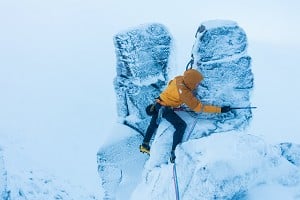
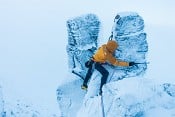




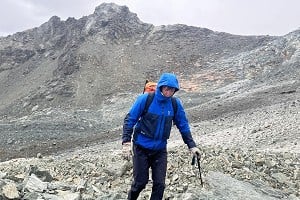
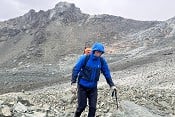





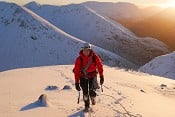
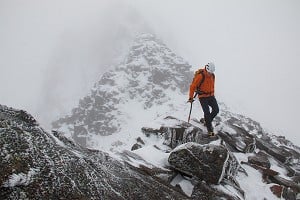

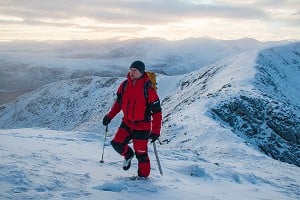
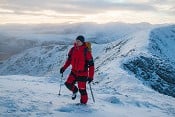
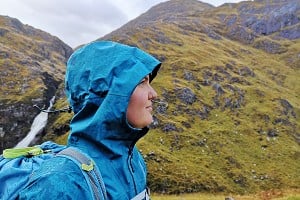
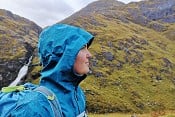


Comments
The hood is definitely not helmet compatible? Just asking because their marketing material very much suggests climbing and mountaineering.
Definitely not. I actually mention the marketing photos in the conclusion, concluding that despite the name, it won't be a very useful coat for a mountain guide.
With my running cap on, I think it'd have strong applications for fell running throughout the cooler months of the year. That breathability, couple with the fact it's waterproof, and offers a bit of insulation, has the potential to make it quite versatile as an active layer.
Interesting,
Haglofs produced a jacket like this many years ago with their mimic insulation on the inside in strategic locations.
My biggest issue was how un-layerable it was (fully aware that probably isn't a word) you had no options for layering etc for when you got too hot or too cold as your insulation and shell where all together so you end up taking another lightweight waterproof and another fleece for options (or just leave the insulated waterproof in the van!!!)
Cool technology but for me a rather unnecessary piece. Potential for a good walking jacket in constant temperature.
Fair points, but I'd say with this one the insulation being pile actually helps wick sweat away so actually helps deal with getting warm inside. I wonder if it could be bonded to goretex pro in the same way? A 3 layer mountain shell with a wicking lining like this could work better for walk-ins than standard designs where I at least feel the sweat so tend to walk in in a windproof.